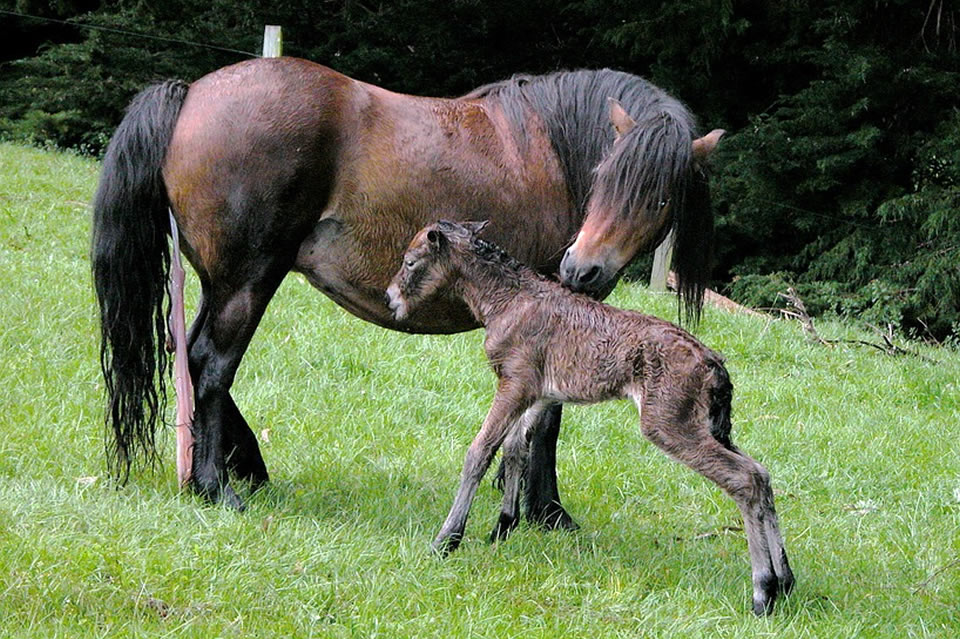BLM Environmental Assessment (EA): Pryor Mountain Wild Horse Range Bait/Water Trap Gather/Fertility Control
The BLM-Billings Field Office has issued a preliminary EA which is proposing a 2018 gather and a modified fertility control plan. Since the release of the plan, we have been very busy gaining understanding of the plan, reviewing and updating our large data base of historic horse records, and writing comments about the proposal. This plan is complex as it combines the two management methods of a gather/removal and fertility control. We have provided a link at the bottom of this post to access the proposal and submit comments. A brief summary of the plan is provided as well as some of the main points we will address in our comments.
The proposed action calls for the removal of 15-20 horses aged 1-4. It also proposes modifications of the fertility control with young mares ages 2 & 3 treated with ZonaStat-H. Mares 4 and above would not receive treatment until after they have successfully foaled twice. The gather process would consist of bait and/or water trapping. It would not utilize helicopters in the gather process. Decisions about the horses for removal would consist of a tiered system based on the number of offspring a mare has had. The target group of 1-4 was determined as young horses are more likely to adjust to a domestic setting and are more desirable by adopters. The rationale for the removal is due to deteriorating range conditions. The adequate management level (AML) of the Pryor Horses is 90-120 (excluding the current year’s foals). The proposed action calls for removals if the number of wild horses exceeds 5% of AML.
The Mustang Center will submit comments in regards to this plan. Our main recommendations include:
- Population: We recommend using current counts of wild horses (at the present time this is about 155 horses). In addition, we have had a low foal birth rate for the past two years and a high death rate. This overall growth rate should be strongly considered when planning any removals.
- Range Conditions: To address range deterioration, we recommend seeking out range management solutions rather than relying only on horse management solutions. The Herd Management Area Plan (HMAP) does offer range management including re-seeding and control of invasive species of plants. It isn’t easy to rehabilitate the fragile ecosystems of the Pryor Mountains, but we do encourage the BLM to seek out and implement possible solutions for improving the range conditions not just for the horses, but for the other wildlife in the area.
- Fertility Control: For many years, the Pryor mares have been treated with PZP. The last two years have shown the results of the management action with low foal crops. The proposed EA has modified the fertility control plan which we believe is beneficial to the herd. For one thing, the younger mares will receive treatment as 2 and 3 year olds, but not as 4 year olds. In addition, the age cap of 9 was removed. This meant that any horse who turned 10 went on treatments regardless of offspring. Now the mares will be left untreated until they have successfully foaled twice. We are supporting this change with the recommendation to better clarify the two-foal change.
- Genetic Preservation: The Pryor horses are a small group with a limited gene pool. It is essential to make management decisions that would have the least impact on the gene pool. We support the proposal in this EA to collect genetic samples, but not just of the removed horses, but from as many horses as possible. The HMAP recommends ensuring that each mare has the opportunity to contribute genetically. We also believe that the stallion genetic contribution is essential. The Mustang Center maintains a chart of horse lineages that date back to the 1970’s. With this list it can easily be seen how many lines have gone extinct due to natural mortality and removals. The genetics of the herd do depend on having an adequate herd population with representation from as many horses as possible.
- Removal Decisions: We would support the proposed action with modification to the proposed Tier Approach. A systematic process can be developed that includes management objectives as defined in the HMAP and included in this proposed EA. This system would evaluate the horses in the target group (ages 1-4) based on those objectives. The number of horses to be removed would be determined by this decision process, not by a pre-set number of horses. We are recommending a very cautious gather this year due to factors listed above of current herd demographics and the need to protect from genetic loss.
The Pryor Horses are a wonderful American treasure. 50 years ago, a group of local citizens led a national movement to preserve the small herd of wild horses which led to the Pryor Mountain Wild Horse Range as the first public wild horse area in the United States. The quest for their preservation continues today.
We do encourage people to submit comments in support of the Pryor Horses. Please use our comment ideas to provide background information, but put them in the context of your experiences/knowledge about wild horses and your interest in them. Make efforts to keep your comments positive and constructive.
Link to the preliminary EA: Comments are due to the BLM by February 16, 2018.

